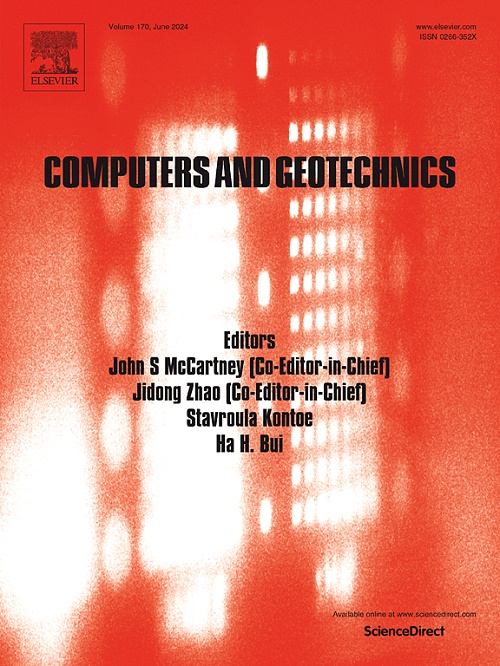土石混合边坡从MPM模型到破坏的退化行为评估
IF 5.3
1区 工程技术
Q1 COMPUTER SCIENCE, INTERDISCIPLINARY APPLICATIONS
引用次数: 0
摘要
土石混合体(SRM)边坡经常发生高度破坏性的退行崩塌。然而,由于固有的结构非均质性和大变形行为,对退变机制仍然知之甚少。本文采用物质点法(MPM)系统地研究了SRM边坡的退化行为。首先,通过近景摄影测量获取岩块轮廓,利用计算几何算法对岩块形态进行量化,建立数字岩块数据库;其次,利用数字图像处理技术建立了SRM斜坡的MPM模型。最后,进行了参数化研究,以评估岩石块体含量(RC)、级配和土壤应变软化特性对SRM边坡后退行为的影响。此外,还通过实验-数值对比分析评估了网格尺寸和颗粒密度的影响。研究结果揭示了钢筋混凝土与级配在控制倒退模式下的耦合效应,并通过软化模量和残余强度对跳动距离产生影响。根据实验验证,建立了模型高度与网格尺寸比和颗粒密度的参考值。研究结果可为SRM边坡的安全评价和加固设计提供理论依据。本文章由计算机程序翻译,如有差异,请以英文原文为准。
An assessment of retrogressive behavior in soil-rock mixture slopes from MPM modelling to failure
Soil-rock mixture (SRM) slopes frequently undergo highly destructive retrogressive collapses. However, the retrogressive mechanisms remain poorly understood due to inherent structural heterogeneity and large-deformation behavior. This study systematically investigates the retrogressive behavior of SRM slopes using the material point method (MPM). Firstly, the rock block contours are acquired by close-range photogrammetry, and the rock block morphologies are quantified with the computational geometry algorithm, so a digital rock block database is established. Secondly, MPM models of SRM slopes are modelled using the digital image processing techniques. Finally, parametric studies are conducted to evaluate the effects of rock block content (RC), gradation, and soil strain-softening property on the retrogressive behavior of SRM slopes. In addition, the influences of grid size and particle density are also assessed through an experimental–numerical comparative analysis. A coupling effect between RC and gradation in governing retrogressive modes is revealed by the results, and the influences on the run-out distance are exhibited by the softening modulus and residual strength. Moreover, reference values for both the model height-to-grid size ratio and particle density are established in accordance with experimental validation. The findings can provide a theoretical foundation for the safety assessment and reinforcement design of SRM slopes.
求助全文
通过发布文献求助,成功后即可免费获取论文全文。
去求助
来源期刊

Computers and Geotechnics
地学-地球科学综合
CiteScore
9.10
自引率
15.10%
发文量
438
审稿时长
45 days
期刊介绍:
The use of computers is firmly established in geotechnical engineering and continues to grow rapidly in both engineering practice and academe. The development of advanced numerical techniques and constitutive modeling, in conjunction with rapid developments in computer hardware, enables problems to be tackled that were unthinkable even a few years ago. Computers and Geotechnics provides an up-to-date reference for engineers and researchers engaged in computer aided analysis and research in geotechnical engineering. The journal is intended for an expeditious dissemination of advanced computer applications across a broad range of geotechnical topics. Contributions on advances in numerical algorithms, computer implementation of new constitutive models and probabilistic methods are especially encouraged.
 求助内容:
求助内容: 应助结果提醒方式:
应助结果提醒方式:


